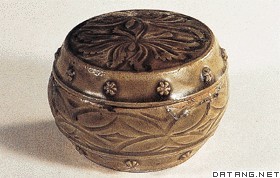2) Qingliangsi Ru Guan kiln


清凉寺汝官窑
1.
The NAA data are further analyzed using fuzzy cluster analysis to determine the provenance relation of Qingliangsi Ru Guan kiln and Juntai Jun Guan kiln.
结果表明 ,清凉寺窑汝官瓷胎和钧台窑钧官瓷胎的原料来源接近 ,但不相同 ;汝官瓷釉和钧官瓷釉的原料来源明显不同 ;汝官瓷和钧官瓷的胎、釉料配方是不同的 ,“钧汝不分”之说不适合于清凉寺汝官窑与钧台钧官
4) Qingliangsi kiln


清凉寺窑
1.
The proton induced X-ray emission(PIXE) was used to measure seven major chemical composition of celadon porcelain body from Qingliangsi kiln in Baofeng and Zhanggongxiang kiln in Ruzhou.
用质子激发X射线荧光分析(PIXE)测定宝丰清凉寺窑汝官瓷胎、民汝瓷胎和汝州张公巷窑青瓷胎的7种主量化学组分,将测得的数据进行散布分析。
2.
Thirty-seven samples of ancient Chinese Ru porcelain bodies unearthed from Qingliangsi kiln(containing 32 Ru official porcelain bodies and 5 Ru folk porcelain bodies),thirty-two samples of ancient celadon bodies from Zhanggongxiang kiln,and fourteen samples of modern mineral,were selected and analyzed by neutron activation analysis(NAA) method.
为研究清凉寺窑汝瓷胎和张公巷窑青瓷胎的原料特征及来源,选取37个清凉寺窑汝瓷胎样品(32个汝官瓷胎和5个汝民瓷胎)、32个张公巷窑青瓷胎样品以及14个岩石样品,用中子活化分析(NAA)方法测得每个样品中的23种元素含量;使用散布分析及主成分分析方法处理NAA数据。
5) Qingliang Temple


清凉寺
1.
On the basis of the conceptual renovating design of Qingliang Temple in Xi an,the author has done research and carded out some practice on how to make the site selection,treatment of space and the shape of the Temple in harmony with the natural environment and the mountainous topography.
结合西安市清凉寺修复规划的设计,对佛寺在选址、空间处理、建筑造型与山地地形及自然环境相融合等方面进行了实践和探索。
6) Qingliangsi in Baofeng


宝丰清凉寺
1.
The Ru kiln site of Qingliangsi in Baofeng has been discovered 8 times since 1986.


汝窑自1986年在宝丰清凉寺发现以来,经过八次考古发掘终于取得了中国陶瓷史上的重大突破,找到并确定了汝官窑瓷器的烧造区。
补充资料:汝窑
| 汝窑 中国北宋后期在汝州建立的官窑。生产青瓷。考古工作者已在河南省宝丰县清凉寺发现汝窑窑址。试掘资料揭示 ,该窑除烧造高档皇家用瓷外,还生产民间用的白釉黑花瓷和钧釉瓷(见磁州窑,钧窑),其青瓷有瓶、樽、碗、洗等 ,釉色天青,淡绿发蓝,犹如蓝色的宝石,釉面有细碎的冰裂纹(开片)。因入窑时用细小支钉垫烧,器底留有细小如麻花的支钉。汝窑生产时间不长,北宋灭亡后停止生产。
|
说明:补充资料仅用于学习参考,请勿用于其它任何用途。
参考词条
